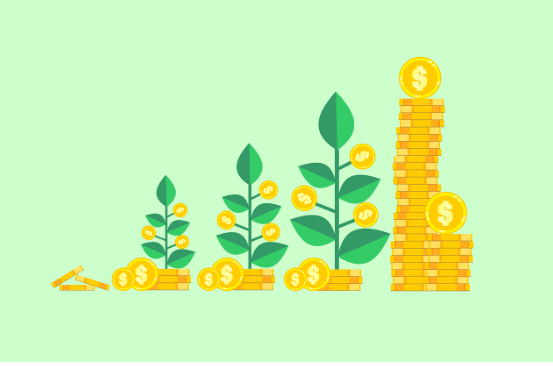The dream of every investor is to watch your portfolio grow year after year with peace of mind and no anxiety over what the market might do next.
The problem is most people pile all their eggs in one basket and get wiped out when the market tanks.
Without diversification, you just won’t succeed.
The good news is…building an investment portfolio that will grow over time and make you money is easy. Really easy.
In fact…it’s not rocket science at all.
It just requires an understanding of a few basic principles that will be reviewed today.
Here’s what you’ll discover:
- The Secret to Surviving Market Crashes is Diversification
- The Building Blocks of an Investment Portfolio
- Smart Asset Allocation Based on Your Timeline
- The Step-by-Step Process to Build a Portfolio
The Secret to Surviving Market Crashes is Diversification
Diversification is the only free lunch in investing.
If you invest all your money in one stock and it crashes, you’re done.
But if you diversify your money across many stocks, bonds, real estate, and other assets, then a crash in one area of the market will not completely wipe you out.
Here’s the thing…
Historical data shows that the traditional 60/40 portfolio (60% stocks/ 40% bonds) has outperformed a 100% stock portfolio about 80% of the time in terms of risk-adjusted returns.
That’s not luck. That’s the power of diversification.
The Building Blocks of an Investment Portfolio
Before you can build an investment portfolio, you need to know what you should be including.
Here are the key pieces that every strong portfolio needs.
Stocks
Stocks are how you build wealth over time.
They are very volatile in the short-term (think days, weeks, months), but over the long-term they tend to offer the highest returns of any asset class.
That doesn’t mean you should put 100% of your portfolio into the hottest tech stock or the next GameStop.
A healthy portfolio should include:
- Large-cap stocks for stability
- Small-cap stocks for higher growth potential
- International stocks for global diversification
Bonds
Bonds are your safety net.
The go-to wealth management advice for when the stock market crashes is always to invest in bonds. Bonds provide stability and income through interest payments.
The combination of bonds with your stocks and other assets will smooth out the overall volatility of your portfolio.
Real Assets
Real estate, commodities, precious metals, and other real assets provide another level of diversification and inflation protection.
When inflation erodes the value of your stocks and bonds, real assets often hold their value.
Smart Asset Allocation Based on Your Timeline
There’s a big problem that most investors don’t understand…
Your asset allocation (the percentage of stocks, bonds, real assets, etc. in your portfolio) should match your timeline.
A 25-year-old saving for retirement should take more risk than a 60-year-old who will retire in 5 years.
Let’s talk about 3 different time horizons…
- If you are young (under 40 years old), you can be more aggressive with 70-80% stocks, 15-20% bonds, and 5-10% alternative investments. You have decades to ride out the market crashes and recover from any losses.
- In your 40s and 50s, you should dial back the risk with 60-70% stocks, 25-30% bonds, and 5-10% alternative investments. It’s a time of life where you are balancing growth with capital preservation.
- If you are nearing retirement, it’s time to protect your nest egg with 40-50% stocks, 40-50% bonds, and 10% cash and alternative investments. You are more concerned with preserving the capital you’ve built over the years.
The Step-by-Step Process to Build a Portfolio
The actual process of building an investment portfolio is straightforward.
Start by assessing your risk tolerance.
Can you emotionally handle watching your portfolio lose 30% of its value without panicking and selling everything?
If yes, you can be more aggressive with your stock allocation.
If no, you need to stick with more conservative investments.
Next, it’s time to choose your investment vehicles.
- Individual stocks and bonds (requires more knowledge and time)
- Index funds and ETFs (cheaper and easier)
- Mutual funds (professionally managed, but often higher fees)
- Target-date funds (automatic rebalancing)
Most people are better off with index funds. Index funds are cheap, simple, and outperform most actively managed funds over time.
The next step is to automate your investing with regular contributions. The best investment plan is the one that you actually follow.
The Secret of Rebalancing Your Portfolio
This is the one part of building an investment portfolio that most people ignore…
Over time, your winners will grow larger and your losers smaller.
Your portfolio’s asset allocation will drift away from your original target.
A portfolio that started with 60% stocks and 40% bonds might grow to 75% stocks after a market rally. This means you have more risk than you initially wanted.
Rebalancing is the process of selling some of your winners and buying more of your losers to restore your target allocation.
It goes against your emotional instinct to sell what’s working, but rebalancing is critical for long-term risk management.
Rebalance at least once a year.
The 5 Mistakes that Kill Most Investment Portfolios
Before we wrap up, let’s review the 5 mistakes to avoid when building an investment portfolio.
- Emotional decisions like panic selling or FOMO buying. Let the market swings knock most people silly, but your portfolio remains untouched.
- Overconcentration in one stock, sector, or asset class. Diversify or die.
- Paying too much in fees. They may seem small, but 1% or 2% a year add up to hundreds of thousands of dollars over decades.
- Neglecting your portfolio. Review it at least annually. Rebalance. Stay the course.
Real Long-Term Returns in the Stock Market are Likely to be between 5% and 7%
You’ve probably seen the headlines from the wealth management firms…
“We expect the stock market to return between X and Y% in the next year/5 years/10 years.”
But here’s the truth no one wants to admit…
Getting rich quick is a myth.
Building real wealth takes time, patience, and discipline.
Current market projections are for about 6% annual returns over the next 10-15 years for diversified portfolios.
That doesn’t sound like a lot, but when you factor in decades of compound growth…
Here’s the math…
A $10,000 investment earning 6% annual returns would be worth $57,435 in 30 years.
Add to that monthly contributions of $500 a month, and you end up with over $500,000 in 30 years.
This is the power of long-term investing in a well-diversified portfolio.
Timing the Market is Impossible. Time in the Market is Everything.
You’ve heard this many times before, but it’s worth repeating…
The best time to start investing is always yesterday. The second-best time is today.
Don’t wait for the “perfect” time to put your money to work. Because there will never be a perfect time.
Markets are always too expensive, too cheap, uncertain, or volatile. There’s always a reason to wait and never a reason to pull the trigger.
Don’t wait any longer.
Put that $100 you have sitting in your checking account to work for you.
If you don’t have $100, put what you have to work for you.
Add to it consistently, no matter what the market is doing.
Don’t try to time the market.
Focus on time in the market, not timing the market.
Conclusion
There you have it…
Building an investment portfolio that will grow over time and create real wealth is simple.
The investors that do it the right way are the ones that diversify across many asset classes, match their asset allocation to their time horizon, contribute regularly, rebalance annually, and stay invested through thick and thin.
It’s not the strategy that makes you a millionaire in a few years.
But it is the only way to build real, lasting wealth over time
That’s the kind of wealth that can fund your retirement, pay for your children’s education, and give you true financial freedom.
And at the end of the day, isn’t that what really matters?











